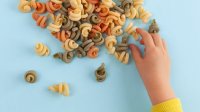The Math Manipulatives Hiding in a Junk Drawer
When parents ask how to get the benefits of manipulatives like base 10 blocks in distance learning, teachers can share strategies for using common household items.
Your content has been saved!
Go to My Saved Content.Math manipulatives, as teachers know, help students develop conceptual understanding by empowering them to build concrete models of abstract ideas. The play that manipulatives encourage is done with purpose, not at random. It provides a common language with which students can describe phenomena and communicate with peers and teachers.
With manipulatives, students create a multidimensional framework on which their math foundation can grow and abstract ideas can come to life. Evidence-based research pointing to the efficacy of the use of manipulatives is strong and shows that student achievement improves over the long term when they are used.
If manipulatives are a key component of your hands-on instructional strategy and these days you’re teaching remotely, you likely have parents with questions about what they can use to replace classroom supplies like color cubes and tiles, bug counters, and base 10 blocks.
The answer is easy: household items found in pantries, toy boxes, sewing kits, and junk drawers.
When parents ask what objects they can use in place of classroom manipulatives, first review with them the concept being taught and explain why the manipulative is used—how it fits in with a specific learning approach. Then share possible substitutions.
With counters, for example, explain to the parent how classroom versions (plastic animals or round counters) are used to help students learn quantity or do addition and subtraction; then suggest alternate items that are alike in size, shape, and possibly color. Dried beans, buttons, and coins are easy substitutes. Those same manipulatives can also work for modeling multiplication or division by combining or creating groups.
For fractions, explain to parents how students use manipulatives such as the counters to arrange items, often of different colors, in groups and identify a portion of a group. Then suggest buttons or beans of different colors. Paper strips cut to equal length and then folded, one in thirds, another in quarters, and so on, can also help students understand which fraction is larger. (Note that the tactile aspect of physically folding the paper is more concrete than a representation by drawing and can really make a difference in the learning component.)
Math Manipulatives From Household Items
Here are additional ways you can offer parents support as they search for manipulatives that can be found or created in the home:
10 frames: First explain what a 10 frame is (a 2x5 rectangular frame of squares) and how they support instruction (they give students visual benchmarks to help see how numbers fit together and develop number sense; teachers often have magnetic versions).
Share with parents how to draw a 10 frame at home: two adjacent, parallel rows of five squares each on a sheet of paper.
To go 3D with 10 frames, suggest that the parent use an egg carton: Cut off the lid and one of the ends, leaving spots for what would have been 10 rather than 12 eggs.
For either version, advise parents to find small objects that fit in the spaces to count.
Linking cubes: Explain to parents how these interlocking, different-colored plastic blocks are great for topics from counting to bar graphs to fractions, and that some varieties of linking cubes connect end to end to make towers, while others snap together on all sides to form geometric shapes. You can suggest components of children’s building-block toys that are similar and can be substituted, or you can suggest using different-colored squares of paper.
Base 10 blocks: Explain to parents how these help children understand 10 and see how place value impacts numbers; students use them to build number combinations, practice regrouping, and discover how they can make “trades” to build larger pieces or break down a figure into smaller pieces. Explain how regrouping is the beginning of understanding the process of carrying or borrowing.
A few suggestions for home substitutes include linking cubes (interlocking plastic blocks) or craft sticks, which students can bundle into groups of 10 with rubber bands. Cutting pieces from graph paper or using pipe cleaners strung with 10 beads for a 10s place would work, too.
Geoboards: Explain to parents how these boards with uniformly spaced, elevated pegs and rubber bands are used to help students understand shapes, areas (arrays), and graphing.
At home, a pegboard or cork board with a uniformly spaced grid will do. Parents can supply pegs or thumbtacks and rubber bands or string.
This is just a start; other teachers and parents will have additional ideas. Keep in mind that virtual models of these manipulatives are available online and offer another mode for students using the same approach.
